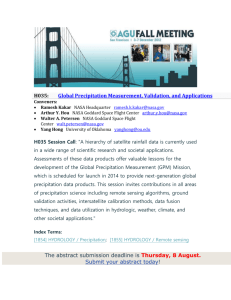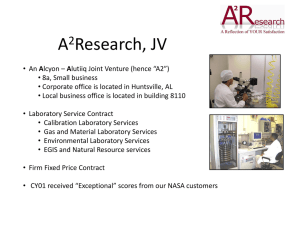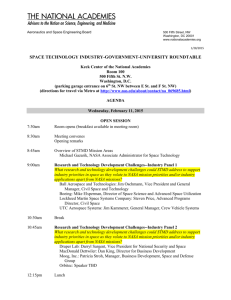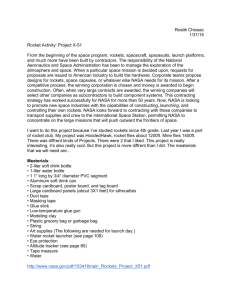TOLNet telecon no. 26 2013.12.19 agenda_v2
advertisement
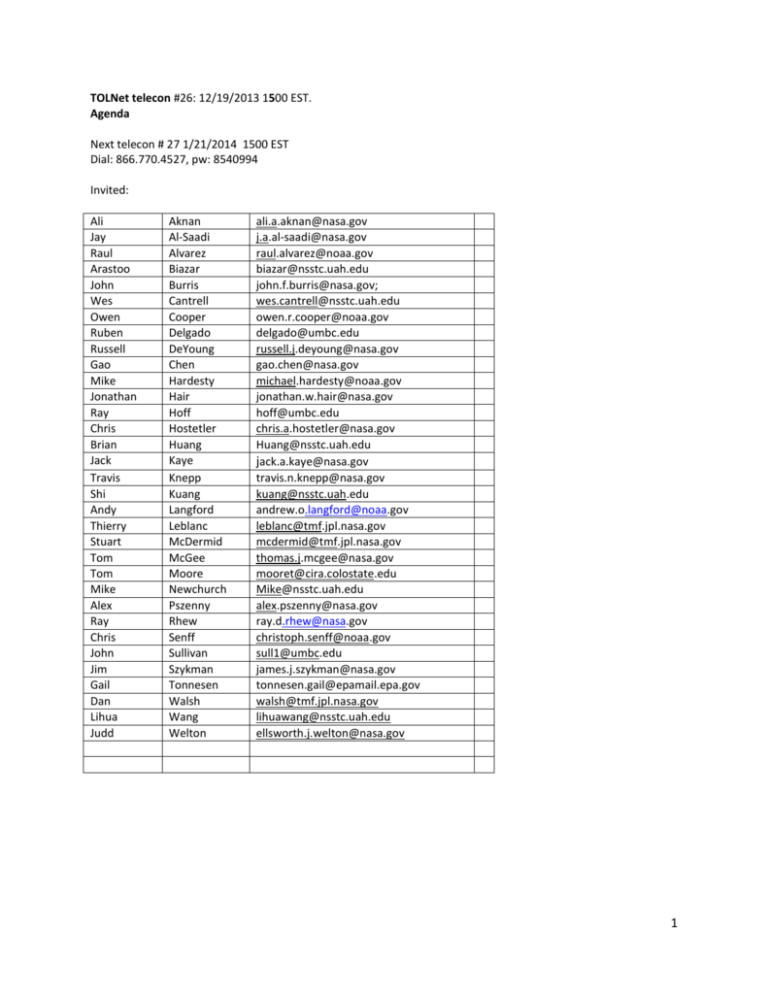
TOLNet telecon #26: 12/19/2013 1500 EST. Agenda Next telecon # 27 1/21/2014 1500 EST Dial: 866.770.4527, pw: 8540994 Invited: Ali Jay Raul Arastoo John Wes Owen Ruben Russell Gao Mike Jonathan Ray Chris Brian Jack Travis Shi Andy Thierry Stuart Tom Tom Mike Alex Ray Chris John Jim Gail Dan Lihua Judd Aknan Al-Saadi Alvarez Biazar Burris Cantrell Cooper Delgado DeYoung Chen Hardesty Hair Hoff Hostetler Huang Kaye Knepp Kuang Langford Leblanc McDermid McGee Moore Newchurch Pszenny Rhew Senff Sullivan Szykman Tonnesen Walsh Wang Welton ali.a.aknan@nasa.gov j.a.al-saadi@nasa.gov raul.alvarez@noaa.gov biazar@nsstc.uah.edu john.f.burris@nasa.gov; wes.cantrell@nsstc.uah.edu owen.r.cooper@noaa.gov delgado@umbc.edu russell.j.deyoung@nasa.gov gao.chen@nasa.gov michael.hardesty@noaa.gov jonathan.w.hair@nasa.gov hoff@umbc.edu chris.a.hostetler@nasa.gov Huang@nsstc.uah.edu jack.a.kaye@nasa.gov travis.n.knepp@nasa.gov kuang@nsstc.uah.edu andrew.o.langford@noaa.gov leblanc@tmf.jpl.nasa.gov mcdermid@tmf.jpl.nasa.gov thomas.j.mcgee@nasa.gov mooret@cira.colostate.edu Mike@nsstc.uah.edu alex.pszenny@nasa.gov ray.d.rhew@nasa.gov christoph.senff@noaa.gov sull1@umbc.edu james.j.szykman@nasa.gov tonnesen.gail@epamail.epa.gov walsh@tmf.jpl.nasa.gov lihuawang@nsstc.uah.edu ellsworth.j.welton@nasa.gov 1 Note from Jay: Note from Alex: EPA et al.: General observations/comments: Retrieval: Station reports TMF: 1) “TOLNet colleagues working on tropospheric ozone retrieval: have you ever thought of correcting for O2 interference?” O2 absorption potential interference issue. See details in Appendix A. ESRL: My AGU presentation is attached. I am happy to go over some of the slides tomorrow. AGU 2013 Senff final.pptx TOPAZ lidar status: - Continue with transmitter optics upgrades - LICEL data acquisition system to be delivered in January Agenda item suggestion: Discuss dates and format of TOLNET workshop. Our calendars for spring are starting to fill up. Our Division Holiday Party is tomorrow. We won't be able to join the telecon before 13:15 MST or so. Please put us last in line for the status update. UAH: 1. Shi Kuang presented the ozone lidar measurements and Guanyu Huang reported the ozone flux study on the 2013 AGU fall meeting. (see Appendix) 2. We summarize the instrument operations for SEAC4RS in Table 1. Table 1. Operation summary for the key instruments in the SEAC4RS campaign Instrument O3 Lidar Sonde Wind Doppler Lidar HSRL Days* 18 32 44 41 Hours 178 N/A 933 984 *Duration counted from 8/8 to 9/24 based on the NASA defined schedule. 2 3. We keep analyzing the SEAC4RS observation data by focusing on the coincident airborne and ground-based measurement days shown in Table 2. Table 2. Dates for DC8 overpassing Huntsville during SEAC4RS Date Objective 8/12 Birmingham plume, Southeastern US (SEUS) biogenics 8/14 Biomass burning 8/21 PBL profiles 8/30 SEUS chemistry(close to Huntsville) 9/6 SEUS chemistry, NAM 9/11 Convection outflow 9/16 Atlanta plume, fires (close to Huntsville) Appendix – Posters of the UAH TOLNet site reported to 2013 AGU Fall Meeting Huang, G., M. J. Newchurch, S. Kuang, L. Wang, W. Cantrell (2013), Ozone Entrainment Flux using Ozone DIAL and Compact Wind Aerosol Lidar (CWAL) in Huntsville AL, AGU Fall Meeting, San Francisco, CA, 9-13 December Kuang, S., M. J. Newchurch, J. Burris, W. Cantrell, P. Cullis, E. Eloranta, G. Huang, B. Johnson, K. Knupp, L. Wang (2013), Ozone observations at Huntsville during the 2013 SENEX and SEAC4RS campaigns, AGU Fall Meeting, San Francisco, CA, 9-13 December Peterson, H. S., S. Kuang, W. J. Koshak, M. J. Newchurch (2013), Correlation of DIAL Ozone Observation with Lightning, AGU Fall Meeting, San Francisco, CA, 9-13 December Reid, J. S., et al., (2013) Aerosol Optical Thickness Patterns and Their Trend in the Southeastern United States, AGU Fall Meeting, San Francisco, CA, 9-13 December 3 4 5 LaRC: This is a curtain plot of the new very near field telescope we added recently. You can see that it starts about 100 m and overlaps our near field channel. On January 10 NI will ship the new analog data system and we will then be able to record this new channel. AGU poster presentation. MobileDeyoung AGU 2013 poster.pdf GSFC: System upgrades to be discussed. 6 Appendix A: O2 Interference. O2_CrossSections_Pl O3TropoDIAL_Extinc ots.pdf tion_Terms.pdf Please find a follow up summary on the O2 absorption potential interference issue I had raised during last telecon. Considering the DIAL wavelength pairs we currently use and the line width of our lasers, there should be no issue with O2. However, the attached figures and summary might be useful if you plan to change your transmitted wavelength in the future, or if you believe that Raman shifting and/or other experimental aberrations might cause a widening of your transmitted beam line width to more than 5 cm-1 (0.1 nm). This is particularly true for wavelengths<282 nm. The list of DIAL pairs in the attached table is not exhaustive. If you would like to know what’s going on for other DIAL pairs, please send me the values of your wavelength pairs (it has to be accurate to 0.02 nm!), and I will compute them as well. You might or might not be interested to discuss the attached material during next week’s telecon. Just let me and Mike know if this should be added to the telecon agenda. A few explanations of the plots: -Page 1: Each of the 3 components of the O2 spectrum . Top plot: as a function of wavenumber, bottom plot: as a function of wavelength - Page 2: Same as Page 1, but with the following additions: - The total O2 cross-section (red curve), - The O2 cross-section measured by SCIAMACHY FM version 1 (Ref. Bogumil, 2003) (brown curve) - The “equivalent cross-section” of the other DIAL absorption terms (O3, NO2, SO2, Rayleigh) These terms are scaled to O2 absorption cross-section, for e.g., if 10 times larger, then it means the product (sigma x N) is 10 times larger than that of O2 (it does not provide info on the differential) - All following pages: Same as bottom plot of Page 2, but zoomed in to several specific DIAL wavelengths Thierry, Thanks for the work! Very helpful! In your table, the magnitude of the DIAL retrieval error due to SO2 for the pair of 285-291 is similar as what we calculated using Rufus et al. 2003, but with opposite sign. In our calculation, the error is negative. But this probably is trivial since the cross section data bases are different and there are a lot of oscillations for SO2 spectrum. However, the SO2 interference for the 289-299 pair looks pretty large, one ppb of SO2 can cause 0.54ppb O3 enhancement (similar as our calculation using Rufus et al.), which is roughly equal to 1% of error assuming a 60ppb O3 background. (Huntsville has stopped to monitor SO2 due to a very low concentration, historic high is 13 ppb). I’m not sure how high the SO2 concentration can be in a polluted 7 city. I believe It can be at least several ppb. This means the SO2 interference for 289/299 may not be trivial for some locations in the PBL. ========================================= Dr. Shi Kuang Hi Kuang, Thanks for your feedback. The scaled values of the SO2 cross-sections can be seen on page 2 of my PDF. They are represented by the (wavy) cyan color curve. For the sign, note that I used the (ON-OFF) difference, so you should indeed subtract the values listed in the table to obtain the corrected O3: O3corr = O3uncorr – error. So when a negative value is present in my table, the O3 final value ends up larger than the uncorrected value. Also the sign of the SO2 term might depend on the exact values of the DIAL wavelengths. I am not completely sure I used the correct wavelengths (i.e., to the 10th of the nanometer). The values I used for this pair are 285.00 nm and 291.00 nm. (source from your IEEE Trans. Article). If you have better-known values (e.g., 285.12), please let me know. 50 ppb SO2 is not uncommon, but this is a peak value. Average city pollution would probably yield values 10 times smaller. (I am no expert in pollution studies so if anyone has better estimates, please speak out) Cheers, Thierry 8
